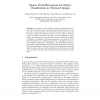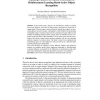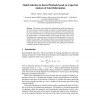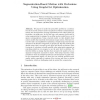DAGM
2006
Springer
14 years 10 months ago
2006
Springer
Abstract. We present a novel model for object recognition and detection that follows the widely adopted assumption that objects in images can be represented as a set of loosely cou...
DAGM
2006
Springer
14 years 10 months ago
2006
Springer
In real world scenes, objects to be classified are usually not visible from every direction, since they are almost always positioned on some kind of opaque plane. When moving a cam...
DAGM
2006
Springer
14 years 10 months ago
2006
Springer
Abstract. We present a method for 3D object modeling and recognition which is robust to scale and illumination changes, and to viewpoint variations. The object model is derived fro...
DAGM
2006
Springer
14 years 10 months ago
2006
Springer
The present paper considers the supplement of prior knowledge about joint angle configurations in the scope of 3-D human pose tracking. Training samples obtained from an industrial...
DAGM
2006
Springer
14 years 10 months ago
2006
Springer
Independent Component Analysis (ICA) is a frequently used preprocessing step in source localization of MEG and EEG data. By decomposing the measured data into maximally independent...
DAGM
2006
Springer
14 years 10 months ago
2006
Springer
Abstract. We propose a novel method for addressing the model selection problem in the context of kernel methods. In contrast to existing methods which rely on hold-out testing or t...
DAGM
2006
Springer
14 years 10 months ago
2006
Springer
Abstract. We propose to tackle the optical flow problem by a combination of two recent advances in the computation of dense correspondences, namely the incorporation of image segme...
FCCM
2004
IEEE
14 years 10 months ago
2004
IEEE
We demonstrate the use of a "smart camera" to accelerate two very different image processing applications. The smart camera consists of a high quality video camera and f...
DSD
2004
IEEE
14 years 10 months ago
2004
IEEE
Cellular Neural Networks are widely used with real-time image processing's applications. Such systems can be efficiently realized using macro enriched fieldprogrammable gate-...
DAGM
2004
Springer
14 years 10 months ago
2004
Springer
Abstract. In this paper, we present an approach for image reconstruction from local phase vectors in the monogenic scale space. The local phase vector contains not only the local p...




